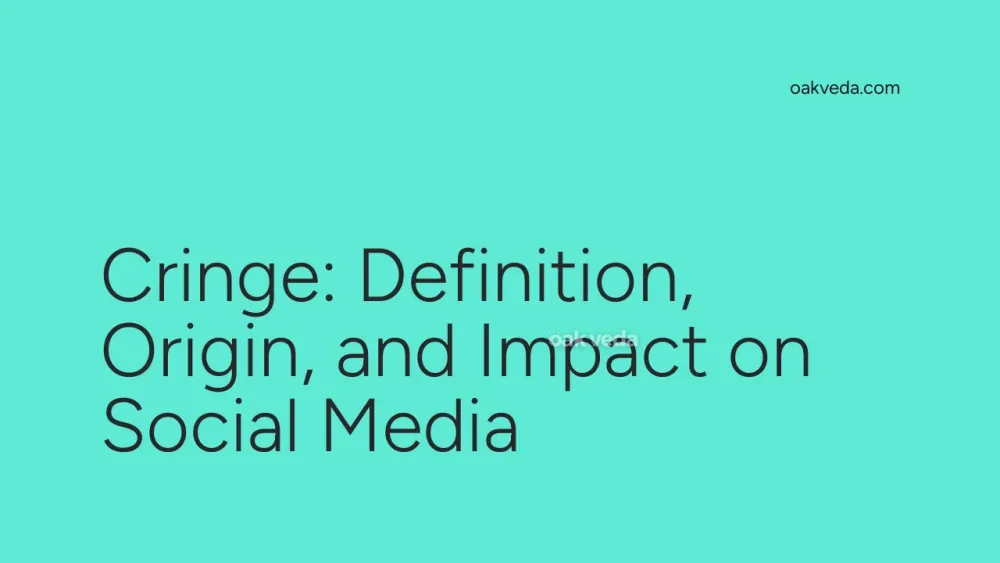
What is Cringe?
In the realm of social media, "cringe" has evolved from a physical reaction to a powerful descriptor of content that evokes secondhand embarrassment or discomfort. It's used to label situations, behaviors, or content that are perceived as awkward, inappropriate, or socially inept. When users describe something as "cringe" or "cringeworthy," they're expressing a visceral reaction to content that makes them feel uncomfortable on behalf of the creator or subject.
Origin and Development of Cringe
The term "cringe" itself isn't new, but its widespread use in social media contexts has given it new life. Originally describing a physical recoil, it has transformed into a subjective judgment of social behavior online. The popularization of "cringe" as a social media term can be traced back to the early 2010s, coinciding with the rise of platforms like YouTube and Tumblr, where users began sharing and reacting to awkward or embarrassing content.
How Cringe Works on Social Media
On social platforms, "cringe" functions as both a verb and an adjective. Users might say they "cringed" at a video, or describe a post as "totally cringe." This term is often employed in comments, captions, or as a hashtag to express disapproval or discomfort with specific content. The power of "cringe" lies in its ability to quickly convey a complex emotional response, making it a shorthand for a range of negative reactions to social faux pas or perceived inauthenticity.
Types of Cringe Content
Cringe content on social media can take various forms:
- Secondhand Embarrassment: Videos or posts where someone is unaware of their awkward behavior.
- Forced or Inauthentic Content: Overly staged or insincere posts, especially from influencers or brands.
- Out-of-Touch Statements: Comments or posts that demonstrate a lack of awareness about current social norms.
- Failed Attempts at Humor: Jokes or memes that miss the mark and come across as awkward instead of funny.
- Oversharing: Personal information or details that most people would consider too private for public consumption.
Popular Examples of Cringe on Social Media
Some notable examples of content often labeled as "cringe" include:
- Poorly executed TikTok dance challenges
- Celebrities making tone-deaf statements about social issues
- Brands attempting to use youth slang inappropriately
- Overproduced "day in the life" videos from influencers
- Public displays of affection that seem staged for social media
Impact of Cringe on Social Media Culture
The concept of "cringe" has significantly influenced online behavior and content creation. It serves as a form of social policing, where users collectively decide what's acceptable or unacceptable in digital spaces. This has led to:
- Increased self-awareness among content creators
- The rise of "cringe compilation" videos and accounts
- A culture of calling out perceived inauthenticity
- The development of "anti-cringe" strategies in content creation
Controversies Surrounding Cringe
The subjective nature of "cringe" has sparked debates about its use and impact:
- Cyberbullying Concerns: Some argue that labeling content as "cringe" can lead to targeted harassment.
- Cultural Differences: What's considered "cringe" can vary significantly across different cultures and age groups.
- Authenticity vs. Performance: The line between genuine self-expression and performative behavior for social media is often blurred.
How Brands and Influencers Navigate Cringe
For brands and influencers, avoiding the "cringe" label has become a crucial aspect of social media strategy:
- Authenticity First: Many are prioritizing genuine, unscripted content to connect with audiences.
- Self-Awareness: Some brands and influencers lean into self-deprecating humor to preempt "cringe" accusations.
- Trend Caution: There's increased hesitation in jumping on every viral trend to avoid forced or inauthentic appearances.
- Community Engagement: Brands are focusing on real interactions rather than overly polished content.
Future Trends Related to Cringe
As social media continues to evolve, so too will the concept of "cringe":
- AI and Cringe: With the rise of AI-generated content, new forms of "uncanny valley" cringe may emerge.
- Cringe Reclamation: Some creators might intentionally embrace "cringe" as a form of avant-garde expression.
- Platform-Specific Cringe: Different social media platforms may develop unique cringe cultures.
- Cringe Analysis: We may see more academic and cultural analysis of "cringe" as a social phenomenon.
FAQs about Cringe
-
Is cringe the same as bad content? No, cringe specifically refers to content that causes secondhand embarrassment or discomfort, not just poor quality.
-
Can something be intentionally cringe? Yes, some creators purposely make "cringe" content for comedic effect or to parody social media trends.
-
How can brands avoid being labeled as cringe? By staying authentic, understanding their audience, and avoiding forced attempts to fit in with trends that don't align with their brand identity.
-
Is cringe culture toxic? It can be when it leads to bullying or shaming, but it can also serve as a form of social feedback and content curation.
-
How has TikTok influenced cringe culture? TikTok has both amplified cringe culture through its trend-driven content and challenged it by normalizing more unfiltered, authentic expressions.
Understanding "cringe" in the context of social media is crucial for navigating online spaces effectively. Whether you're a casual user, content creator, or brand strategist, being aware of what might be perceived as cringe can help in crafting more authentic and well-received content in the ever-evolving digital landscape.
You may be interested in:
- Ick: Definition, Origin, and Impact on Social Media Culture
- Retargeting: Definition, Origin, and Impact on Social Media
- Innit: Definition, Origin, and Impact on Social Media
- AI in Social Media: Definition, Origin, and Impact
- Stan: Definition, Origin, and Impact on Social Media Culture
- OOMF: Definition, Origin, and Impact on Social Media

